 INVESTMENT INVESTMENT |
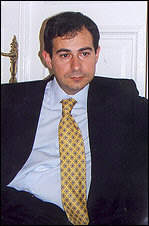
Romania received foreign investments of US$ 256.2 million in 1999, only US$ 28 million more than in 1998, and a considerable decrease from the record US$ 896 million that the country was able to attract in 1994. Compared with the billions of dollars poured into the other Central European countries (Poland, Czech Republic, Hungary), one can but wonder why aren't foreign investors more attracted to this country. As Mr. Salvatore Candido, Director of the European Bank for Reconstruction and Development, EBRD put it "a slow pace of reform combined with the inconsistent and often confused handling of investors has indeed negatively hit the level of foreign investment". "Investors are sensitive to the negative international rating of Romania [ Romania has been rated as high-risk country by Standard & Poors] , the three years of recession and the fact that macroeconomic stabilization has still not been achieved". All this added to the Kosovo crisis, which seriously affected the region, and the ever-changing tax and investment laws are sufficient reasons to make foreign investors jittery. Indeed, "investors want to be assured that there is a stable framework to rely on and that this framework will not change from one day to another" explains Mr. Candido. "When we refer to a strong investment climate we mean a strong package o laws and rules that ensure a level playing field and long-term stability. The real credibility of such a package is not so much what is on offer, but how effectively it will be maintained", adds the Director of the EBRD. So far that seems to be what the Government is concentrating on, setting the foundations for a stable investment environment, regardless of who wins the elections.
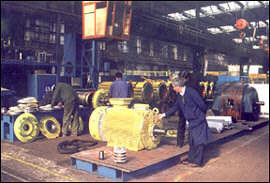
However most investors, private or institutional, that have decided to plunge their money into Romania have not regretted it. On the contrary, they have obtained significant gains and returns on capital. In fact, the European Bank for Reconstruction and Development, EBRD is the single largest investor in the country. Since they first got established here in 1992, they have mobilized 5 billion Euro investing in 55 different projects. Today Romania is the second largest recipient of funding by the EBRD, only after Russia. Even though they started investing in public sector operations such infrastructure projects, they have gradually diversified their portfolio into private sector operations that are more profitable. For instance, in the domain of telecommunications EBRD has taken stakes at CONNEX- Mobifon, one of the two most successful mobile phone operators in Romania. In the financial sector, the EBRD has recently participated in the privatization of the Romanian Development Bank and Bank Post, to mention but two, and they have purchased a large package of shares into manufacturing companies such as Arctic, Parmalat or Lafarge-Romcim. The generous contribution of EBRD into the equity of local firms has allowed many companies to regain competitiveness both in the local market and in the international arena. "We measure our success - says Mr. Candido - not only by our ability to push forward the transition, but also by our ability to attract other lenders and new investors".
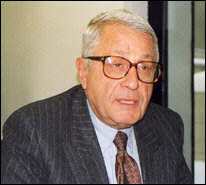
Not only the Europeans have realized of the potential
Romania has to offer. The Romanian
American Enterprise Fund, RAEF, was created
in 1994 by a law enacted by the US Congress. As
Mr.
John Klipper, its President and CEO explains,
"our role here is to force them into the free market
economy and to be a magnet for private funds. We
have to demonstrate that you can do business in
Romania, so that private investors gain enough confidence".
The Fund started with a modest US$ 50 million grant,
but by way of raising private funds, they have been
able to spread their activities particularly centering
in small and medium enterprises. From 1995 to 1998
RAEF invested well over US$ 60 million in 18 companies.
|
Since Mr. Klipper believes that "small businesses are the ones that hopefully grow and create the jobs that this country needs", the Fund has also created a Small Business Investment Fund that invests in equity in small companies of about US$ 200,000 capital. Despite their slow start, at the end of 1999 they had already raised US$ 2.5 million. In fact, that same year they became controlling shareholders of the Banca Romaneasca, a young bank specialized mostly in small and medium enterprises. Through this acquisition, RAEF has started operating like a venture capital fund. It has improved its financial position and it has allowed them to expand their field of operations using the whole network of the bank.
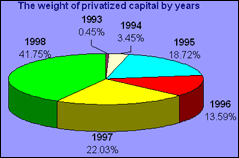
While foreign financial institutions are making a killing by investing in small and medium enterprises, other institutions such as the Regional Development Agency are trying to attract foreign capital and investments into less developed areas in the country. On the other hand, the State Ownership Fund (SOF) is actively trying to privatize the largest companies in the country that have not yet been sold. The privatization process in Romania has been hindered a lack of political will. While in the early 90's Central European countries were busily selling their formerly state-owned companies, Romania did not. In fact, we could say that only after 1996, when the present coalition was elected, very few companies had been sold. 90% of those that were actually disposed of by the government were sold to their employees "delaying re-capitalization and having a negative impact on technologies and the environment" says Mr. Radu Sarbu, Chairman of SOF.
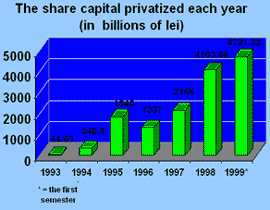
Of the original 9,000 companies in the SOF portfolio, around 6,500 have already been sold, although most of them were either small or middle sized. The companies that SOF still controls represent around 48% of the total social capital of the Romanian economy. The privatization of many of these companies is no easy task, since many of them are inefficient, plagued with debts, and over-staffed. Due to their large size and prices, potential buyers are mostly multinational companies. However, before any foreign group decides to purchase, SOF is working on making these companies more attractive by restructuring them. Albeit, Mr. Sarbu explains that SOF cannot invest in the companies "because we do not have money. We reduce their production according to the market they have and their personnel according to the production". So far, this technique seems to be working. Before 1996 only 11 companies had been purchased by foreign capital. In the next three years 250 were sold to foreign bidders. In fact, resumes Mr. Radu Sarbu, "In our transactions the price is not the main component, but the investments granted by the contract. Technology and a managerial plan in some cases are more important priorities than the money investors can bring".
The largest investments have been done by French companies. Lafarge, which bought a cement plant, Société Générale that just acquired the Romanian Development Bank, or Renault, who purchased the Romanian car factory Dacia are a good example of that. The Korean company Daewoo has also disembarked in the Romanian market through the purchase of another car plant. However both car manufacturers seem to be going through dire straits and are menacing to pull out of the country, although that does not seem to be the generality. Most privatizations done so far are success stories. 80% of the privatized companies are doing better now than before" claims the chairman of SOF, and those with a negative performance are mostly the ones acquired by the Unions. By far, some of the most successful privatization cases are those made in the banking sector. |

